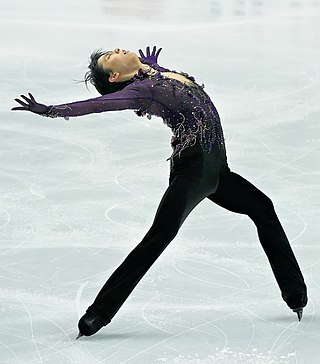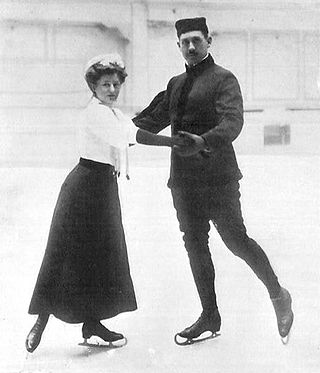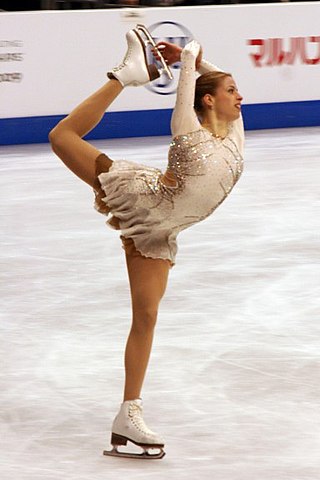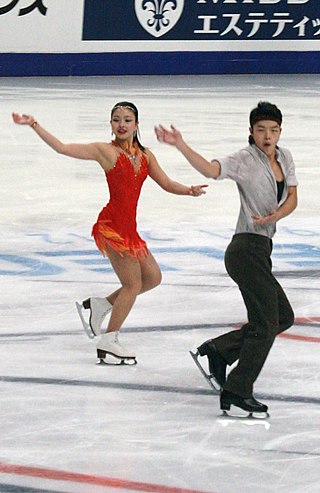
Figure skating is a sport in which individuals, pairs, or groups perform on figure skates on ice. It was the first winter sport to be included in the Olympic Games, when it was contested at the 1908 Olympics in London. The Olympic disciplines are men's singles, women's singles, pair skating, and ice dance; the four individual disciplines are also combined into a team event, which was first included in the Winter Olympics in 2014. The non-Olympic disciplines include synchronized skating, Theater on Ice, and four skating. From intermediate through senior-level competition, skaters generally perform two programs, which, depending on the discipline, may include spins, jumps, moves in the field, lifts, throw jumps, death spirals, and other elements or moves.
Figure skating jumps are an element of three competitive figure skating disciplines: men's singles, women's singles, and pair skating – but not ice dancing. Jumping in figure skating is "relatively recent". They were originally individual compulsory figures, and sometimes special figures; many jumps were named after the skaters who invented them or from the figures from which they were developed. It was not until the early part of the 20th century, well after the establishment of organized skating competitions, when jumps with the potential of being completed with multiple revolutions were invented and when jumps were formally categorized. In the 1920s Austrian skaters began to perform the first double jumps in practice. Skaters experimented with jumps, and by the end of the period, the modern repertoire of jumps had been developed. Jumps did not have a major role in free skating programs during international competitions until the 1930s. During the post-war period and into the 1950s and early 1960s, triple jumps became more common for both male and female skaters, and a full repertoire of two-revolution jumps had been fully developed. In the 1980s men were expected to complete four or five difficult triple jumps, and women had to perform the easier triples. By the 1990s, after compulsory figures were removed from competitions, multi-revolution jumps became more important in figure skating.

Spins are an element in figure skating in which the skater rotates, centered on a single point on the ice, while holding one or more body positions. They are performed by all disciplines of the sport, single skating, pair skating, and ice dance, and are a required element in most figure skating competitions. As The New York Times says, "While jumps look like sport, spins look more like art. While jumps provide the suspense, spins provide the scenery, but there is so much more to the scenery than most viewers have time or means to grasp". According to world champion and figure skating commentator Scott Hamilton, spins are often used "as breathing points or transitions to bigger things"
The toe loop jump is the simplest jump in the sport of figure skating. It was invented in the 1920s by American professional figure skater Bruce Mapes. The toe loop is accomplished with a forward approach on the inside edge of the blade; the skater then switches to a backward-facing position before their takeoff, which is accomplished from the skater's right back outside edge and left toepick. The jump is exited from the back outside edge of the same foot. It is often added to more difficult jumps during combinations and is the most common second jump performed in combinations. It is also the most commonly attempted jump.
A twizzle is "a multirotational, one-foot turn that moves across the ice" in the sport of figure skating. First performed by David Grant in 1990 the International Skating Union (ISU) defines a twizzle as "a traveling turn on one foot with one or more rotations which is quickly rotated with a continuous (uninterrupted) action". It is most often performed in ice dance, although single skaters and pair skaters also perform the element. Twizzles have been called "the quads of ice dance" because like quadruple jumps in other disciplines, twizzles are risky and technically demanding.

Pair skating is a figure skating discipline defined by the International Skating Union (ISU) as "the skating of two persons in unison who perform their movements in such harmony with each other as to give the impression of genuine Pair Skating as compared with independent Single Skating". The ISU also states that a pairs team consists of "one Woman and one Man". Pair skating, along with men's and women's single skating, has been an Olympic discipline since figure skating, the oldest Winter Olympic sport, was introduced at the 1908 Summer Olympics in London. The ISU World Figure Skating Championships introduced pair skating in 1908.
The ISU Judging System (or the International Judging System (IJS)), occasionally referred to as the Code of Points (COP) system, is the scoring system that has been used since 2004 to judge the figure skating disciplines of men's and ladies' singles, pair skating, ice dance, and synchronized skating. It was designed and implemented by the International Skating Union (ISU), the ruling body of the sport.
The following is a glossary of figure skating terms, sorted alphabetically.

Single skating is a discipline of figure skating in which male and female skaters compete individually. Men's singles and women's singles are governed by the International Skating Union (ISU). Figure skating is the oldest winter sport contested at the Olympics, with men's and women's single skating appearing as two of the four figure skating events at the London Games in 1908.
The free skating segment of figure skating, also called the free skate and the long program, is the second of two segments of competitions, skated after the short program. Its duration, across all disciplines, is four minutes for senior skaters and teams, and three and one-half minutes for junior skaters and teams. Vocal music with lyrics is allowed for all disciplines since the 2014—2015 season. The free skating program, across all disciplines, must be well-balanced and include certain elements described and published by the International Skating Union (ISU).

Figure skating lifts are required elements in two disciplines of figure skating, pair skating and ice dance. There are five groups of lifts in pair skating, categorized in order of increasing level of difficulty. Judges look for the following when evaluating pair lifts: speed of entry and exit; control of the woman's free leg when she is exiting out of the lift, with the goal of keeping the leg high and sweeping; the position of the woman in the air; the man's footwork; quick and easy changes of position; and the maintenance of flow throughout the lift. Twist lifts are "the most thrilling and exciting component in pair skating". They can also be the most difficult movement to perform correctly. They require more strength and coordination than many other pair elements, and are usually the first or second element in a program. According to the International Skating Union (ISU), "the Woman must be caught in the air at the waist by the Man prior to landing and be assisted to a smooth landing on the ice on a backward outside edge on one foot" during a twist lift. A pair lift and twist lift is required in the short program of pair skating; a well-balanced free skating program in pair skating must include lifts.

A quad, or quadruple, is a figure skating jump with at least four revolutions. All quadruple jumps have four revolutions, except for the quadruple Axel, which has four and a half revolutions. The quadruple toe loop and quadruple Salchow are the two most commonly performed quads. Quadruple jumps have become increasingly common among World and Olympic level men's single skaters, to the point that not performing a quad in a program has come to be seen as a severe handicap. This phenomenon is often referred to as the "quad revolution". Since 2018, quadruple jumps have also become an increasingly common feature of women's skating, although they are not allowed under the International Skating Union ("ISU") rules in the ladies' short program. The first person to land a ratified quadruple jump in competition was Canadian Kurt Browning in 1988. Japanese skater Miki Ando became the first female to do so, in 2002.
British Ice Skating is the national governing body of ice skating within the United Kingdom. Formed in 1879, it is responsible for overseeing all disciplines of ice skating: figure skating ; synchronised skating; and speed skating.
A step sequence is a required element in all four disciplines of figure skating, men's single skating, women's single skating, pair skating, and ice dance. Step sequences have been defined as "steps and turns in a pattern on the ice". Skaters earn the most points in step sequences by performing steps and movements with "flair and personality", by turning in both directions, by using one foot and then the other, and by including up and down movements.
The Axel jump or Axel Paulsen jump, named after its inventor, Norwegian figure skater Axel Paulsen, is an edge jump performed in figure skating. It is the sport's oldest and most difficult jump, and the only basic jump in competition with a forward take-off, which makes it the easiest to identify. A double or triple Axel is required in both the short program and the free skating segment for junior and senior single skaters in all events sanctioned by the International Skating Union (ISU).

Bradie Tennell is an American figure skater. She is a 2018 Olympic team event bronze medalist, the 2020 Four Continents bronze medalist, the 2018 CS Autumn Classic champion, the 2018 CS Golden Spin of Zagreb champion, and a two-time U.S. national champion.

Ice dance, a discipline of figure skating, has required elements that make up a well-balanced rhythm dance program and free dance program, which must be performed during competitions. They include: the dance lift, the dance spin, the step sequence, turn sequences, and choreographic elements. The elements must be performed in specific ways, as described by published communications by the International Skating Union (ISU), unless otherwise specified. The ISU has also provided a list of illegal movements.
The rhythm dance (RD) is the first segment of an ice dance competition. The International Skating Union (ISU) renamed the short dance to the "rhythm dance" in June 2018, prior to the 2018–2019 season. It became part of international competitions in July 2018. French ice dancers Gabriella Papadakis and Guillaume Cizeron hold the highest RD score of 90.83 points, which they achieved at the 2022 Beijing Winter Olympics.
A choreographic sequence is a required element for figure skating in all international competitions. It is required in the free skating programs of senior and junior single skaters and in the free skating programs of senior pair skaters. It is also required during ice dancers' rhythm dances and free dances. Judges do not evaluate individual elements in a choreographic sequence; rather, they note that it was accomplished. Skaters must fulfill certain requirements to fulfill the highest points possible during choreographic sequences. There are six types of choreographic elements in ice dance: the Choreographic lift, the Choreographic spinning movement, the Choreographic assisted jump movement, the Choreographic twizzling movement, the Choreographic sliding movement, and the Choreographic character step sequence.
The 2019–20 Grand Prix of Figure Skating Final and ISU Junior Grand Prix Final was held from December 5–8, 2019 at the Torino Palavela in Turin, Italy. The combined event was the culmination of two international series — the Grand Prix of Figure Skating and the Junior Grand Prix. Medals were awarded in the disciplines of men's singles, ladies' singles, pair skating, and ice dance on the senior and junior levels.











